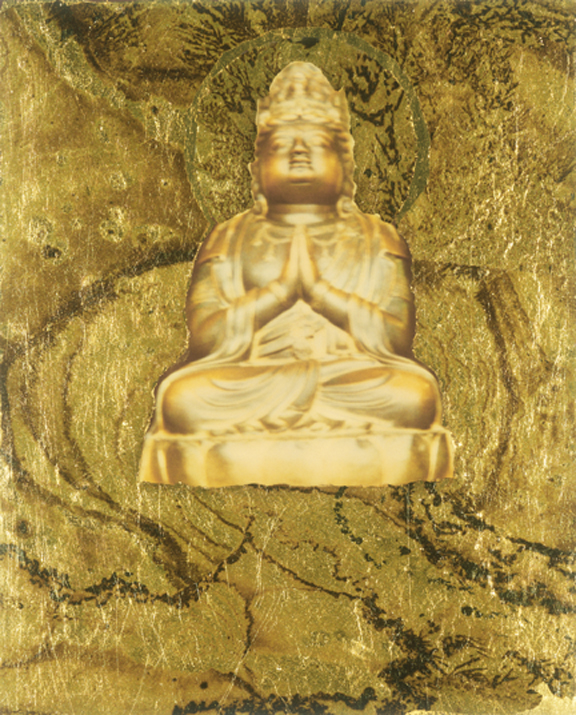In 1966, a new television program called Star Trek hit the air waves. Captain Kirk, Mr. Spock and “Scotty” embarked upon an odyssey into outer space that captured the attention of children of all ages. Simultaneously, NASA’s real space adventurers rocketed into orbit, culminating in 1969 with Neil Armstrong’s and Buzz Aldrin’s historic hops, skips and jumps on the moon’s dusty surface. Cameras captured their exuberantly planted footsteps and transmitted their images to earth where a teenager who had dreamed of becoming an astronaut watched in amazement. Inspired by these real and fictional voyages that stimulated his imagination, Victor Raphael, that awe-struck California teen, became a modern-day trekker and explorer in his own right, investigating the expansiveness and minutia of the universe without ever stepping aboard the Starship Enterprise or an Apollo capsule.
Raphael’s vehicle of discovery is art. His tools? A rich pastiche of the old and the avant-garde: paints, brushes, cameras, film, electronic signals, computers and printers. He delves into the past to express his ideas with works on canvas, but also seizes the latest contemporary inventions to articulate his vision. Representing a mix of low and high technology, a Polaroid camera became Raphael’s constant companion in the 1980s, providing point-and-shoot spontaneity, instant feedback and a unique print.
When NASA broadcast views of space into his living room, Raphael made time stand still with the push of the Polaroid camera’s button. On his television screen, the orbiting planets and streaking comets froze against their cosmic backdrop in the resulting photographs. But these were just starting points, essentially blank canvases that demanded the artist’s imprint. Ever the alchemist, Raphael transmuted the ordinary into the extraordinary, dramatizing these soft-focused celestial objects by adding dabs of acrylic paint and gold and metal leaf to the surface of the prints. The embellishments created a physicality that thrust the photographs into a new dimension.
As a seeker of knowledge and interpreter of his observations, Raphael travels through time and place, investigating mankind’s creations, gathering physical evidence and mental impressions of each encounter. Visiting Jackson Pollock’s home and studio in Springs, Long Island, in 1985, Raphael made Polaroid Type 600 instant photographs that permanently intertwined his own presence with the creative spirit of this idolized figure who had once walked these grounds. Raphael captured shadows and gathered inspiration. Back at his own studio, he recalls this pilgrimage and transfers his emotional remembrances onto the prints using acrylic and metal paint. Self Portrait at Pollock Studio illustrates the materiality of the man while ellipses, tangles and swirls of paint in another photograph echo Pollock’s groundbreaking Abstract Expressionism style and the emotional discord that tortured the painter’s soul.
Touring Japan’s temples, shrines, museums and city centers, Raphael takes snapshots of cultural symbols. In Golden Buddha, 2001, an antique Buddha floats above undulating waves of applied gold leaf that isolate and punctuate the figure, intensifying its devotional intent. Prowling through the Louvre in Paris, Raphael discovers tiny, earth-bound nudes sculpted in stone thousands of years ago. They provide a glimpse into an ancient civilization, yet Raphael removes them from their context, juxtaposing them with psychedelic colors and patterns recalling Haight-Ashbury during the “Age of Aquarius” in Three Female Statuettes. Treasured remnants of the past are teleported to a more recent environment that alters those historic references.
Caused by Raphael’s subtle camera movement, lantern lights morph into abstract markings against a midnight sky. Monet’s water lilies float on still water, enlivened by strokes of copper and gold. Arabesques of motion, the water’s rippling surface, appear as if snakes of metal leaf are skimming across Tokyo ponds and lakes. Raphael records the familiar, material world and manipulates it into uncharted territory. He strives to present more than just a record of a person, place or thing; instead, he seeks to create a visual representation of ideas, emotions, and spiritual and intellectual musings. His photographs are striking, beautiful, complex and, above all, a window into an inquiring mind. Cerebral in content and process, these photographs are more than pretty pictures.
In pushing the aesthetic and technological envelope to explore new ways of visualizing both interior and exterior worlds, Raphael joins an elite group of artists who seek novel and original ways of expressing their visions. His multi-faceted creative outpouring enriches and expands the photographic vocabulary. It also grabs our attention, sparks our curiosity and fuels our imagination. Each splash of paint and swath of gold transports us into Victor Raphael’s own private universe. We are at his side, reveling in his every adventure.
A retrospective of Victor Raphael’s work is on view at the Griffin Museum near Boston, Sept. 22-Dec. 4.

